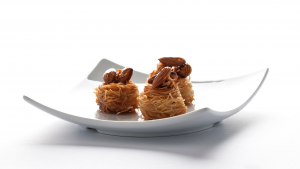
The Science of Coffee Aromas: What Makes That First Sip So Irresistible?
Table of Contents
- The Complex Chemistry of Coffee Aromas
- How Are Coffee Aromas Created?
- The Key Aroma Compounds in Coffee
- How Roasting Levels Affect Aroma
- Why Coffee Smells So Good to Humans
- Biological Factors
- Psychological Factors
- How Brewing Methods Influence Aroma
- Preserving Coffee Aromas
- Tips for Storing Coffee:
- Tips for Brewing:
- The Role of Coffee Aromas in Taste
- The Future of Coffee Aromas
- Conclusion: The Irresistible Allure of Coffee Aromas
The Science of Coffee Aromas: What Makes That First Sip So Irresistible?
- Adam Smith
- 24-12-2024
- 29-07-2025
- 1064 views
- Featured Articles

There’s nothing quite like the rich, tantalizing aroma of freshly brewed coffee. That first whiff in the morning can awaken your senses and prepare you for the day ahead. But what exactly is it about coffee’s aroma that makes it so irresistible? In this blog, we’ll delve into the science behind coffee aromas, explore the chemical compounds responsible for its signature scent, and uncover why our brains are hardwired to love it.
The Complex Chemistry of Coffee Aromas
Coffee aroma is one of the most complex and intricate in the world of food and beverages. A single cup of coffee can contain over 800 volatile compounds that contribute to its smell, making it a sensory experience like no other.
How Are Coffee Aromas Created?
The unique aroma of coffee is created during the roasting process. Green coffee beans have very little aroma, but once they are roasted, a series of chemical reactions transform the beans into aromatic powerhouses.
- Maillard Reaction: This is the reaction between amino acids and sugars that occurs when the beans are heated. It produces a range of nutty, roasted, and caramel-like aromas.
- Caramelization: The sugar in the beans breaks down during roasting, creating sweet, caramel-like notes.
- Pyrolysis: This is the breakdown of organic matter during roasting, which contributes smoky, earthy, and complex scents.
The Key Aroma Compounds in Coffee
While there are hundreds of compounds in coffee, some play a particularly important role in its aroma:
- Furans: Responsible for the nutty and caramel-like scents.
- Thiols: These compounds contribute to coffee’s roasty, earthy notes. 2-Furfurylthiol, in particular, gives coffee its characteristic fresh-brewed aroma.
- Pyrazines: Add nutty and roasted flavors.
- Phenols: Provide smoky and spicy undertones.
- Esters and Aldehydes: Contribute fruity and floral aromas, particularly in lighter roasts.
How Roasting Levels Affect Aroma
The level of roast significantly influences the aroma profile of coffee:
- Light Roast: Retains more fruity, floral, and acidic notes due to minimal caramelization and Maillard reactions.
- Medium Roast: Balances acidity and sweetness, highlighting caramel and nutty aromas.
- Dark Roast: Dominated by smoky, chocolaty, and bitter notes as a result of extended roasting.
Why Coffee Smells So Good to Humans
Our love for coffee’s aroma isn’t just a coincidence—it’s rooted in both biology and psychology.
Biological Factors
- Olfactory Sensitivity: Our sense of smell is incredibly sensitive to certain compounds found in coffee, especially those that evoke warmth and comfort.
- Memory and Emotion: The olfactory system is directly connected to the limbic system, the part of the brain responsible for emotions and memories. This is why the smell of coffee can instantly evoke feelings of nostalgia or happiness.
Psychological Factors
- Conditioning: Over time, many of us associate the smell of coffee with positive experiences, such as cozy mornings, productivity, or social gatherings.
- Cultural Influence: In many cultures, coffee is a symbol of sophistication, warmth, and connection, further enhancing its appeal.
How Brewing Methods Influence Aroma
The way you brew your coffee also impacts its aroma profile. Here’s how popular methods differ:
- Espresso: Concentrates the most aromatic compounds, resulting in a bold, intense aroma.
- Pour-Over: Enhances fruity and floral aromas by controlling the water flow and extraction time.
- French Press: Produces a rich, full-bodied aroma due to the immersion brewing method.
- Cold Brew: Offers a milder, sweeter aroma with reduced acidity.
Preserving Coffee Aromas
To fully enjoy the aromatic qualities of coffee, proper storage and preparation are key.
Tips for Storing Coffee:
- Store beans in an airtight container away from light, heat, and moisture.
- Grind beans just before brewing to preserve volatile compounds.
- Avoid refrigerating or freezing coffee unless absolutely necessary.
Tips for Brewing:
- Use freshly roasted, high-quality beans.
- Ensure your water is at the right temperature (195°F to 205°F).
- Experiment with grind size and brewing time to optimize aroma extraction.
The Role of Coffee Aromas in Taste
Aroma plays a significant role in how we perceive flavor. In fact, up to 80% of what we perceive as taste comes from our sense of smell. This is why a stuffy nose can make food and beverages seem bland. Coffee’s rich aroma enhances its perceived sweetness, bitterness, and complexity, making it an integral part of the overall experience.
The Future of Coffee Aromas
As coffee science advances, researchers are finding new ways to enhance and manipulate coffee aromas:
- Specialty Breeding: Developing coffee plants with unique aromatic profiles.
- Controlled Fermentation: Using specific fermentation techniques to enhance fruity and floral notes.
- Aroma Capsules: Adding concentrated aromatic compounds to coffee products for an elevated sensory experience.
Conclusion: The Irresistible Allure of Coffee Aromas
The aroma of coffee is a symphony of science and sensory pleasure. From the intricate chemical reactions during roasting to the personal memories it evokes, coffee’s smell is truly magical. By understanding the science behind it, you can better appreciate every sip and make your coffee experience even more delightful.
So, the next time you take that first sip of coffee, pause for a moment to savor its aroma—and remember the fascinating journey it has taken to reach your cup.






















